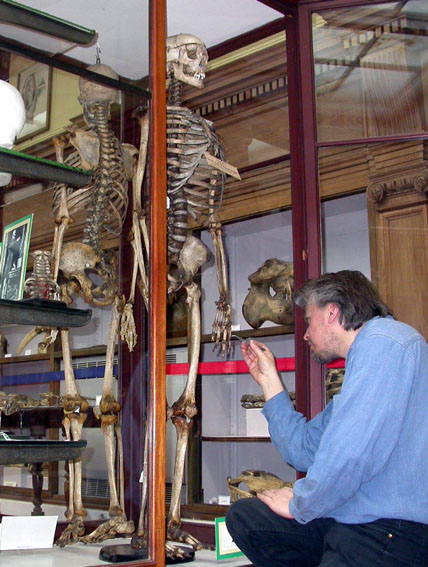Cleaning the skeleton of William Burke, the famous Edinburgh ‘body-snatcher’ and murderer
 Serial murders perpetrated in Edinburgh in 1827/8 were attributed to the Irish immigrants William Burke and William Hare, who sold the
corpses of their 17 victims for dissection and study. Their purchaser was Doctor Robert Knox, a private anatomy lecturer whose students were
drawn from Edinburgh Medical College. Before 1832, there were insufficient cadavers legitimately available for the study and teaching of anatomy
in British medical schools. The University of Edinburgh was an institution universally renowned for medical sciences. As medical science began to
flourish in the early nineteenth century demand rose sharply but at the same time the only legal supply of cadavers—the bodies of executed
criminals—had fallen due to a sharp reduction in the execution rate in the early nineteenth century, brought about by the repeal of ‘the Bloody Code’.
Only about two or three corpses per year were available for a large number of students. This situation attracted criminal elements who were willing to
obtain specimens by any means. The activities of body-snatchers gave rise to particular public fear and revulsion.
It was a short step from grave-robbing to murder. William Burke is the most notorious of the murderers that were caught.
With thanks to Wikipedia. See
http://en.wikipedia.org/wiki/Burke_and_Hare_murders
for more details.
Serial murders perpetrated in Edinburgh in 1827/8 were attributed to the Irish immigrants William Burke and William Hare, who sold the
corpses of their 17 victims for dissection and study. Their purchaser was Doctor Robert Knox, a private anatomy lecturer whose students were
drawn from Edinburgh Medical College. Before 1832, there were insufficient cadavers legitimately available for the study and teaching of anatomy
in British medical schools. The University of Edinburgh was an institution universally renowned for medical sciences. As medical science began to
flourish in the early nineteenth century demand rose sharply but at the same time the only legal supply of cadavers—the bodies of executed
criminals—had fallen due to a sharp reduction in the execution rate in the early nineteenth century, brought about by the repeal of ‘the Bloody Code’.
Only about two or three corpses per year were available for a large number of students. This situation attracted criminal elements who were willing to
obtain specimens by any means. The activities of body-snatchers gave rise to particular public fear and revulsion.
It was a short step from grave-robbing to murder. William Burke is the most notorious of the murderers that were caught.
With thanks to Wikipedia. See
http://en.wikipedia.org/wiki/Burke_and_Hare_murders
for more details.
In a way it is fitting that after he was convicted and hanged Burke's body was taken to the the University of Edinburgh to be dissected.
His skeleton is now in the University’s Museum of Anatomy. Recently it has been studied for biomolecular research but unfortunately
the skeleton seems to have been partly wrapped in a blanket for protection.
This left a mass of tiny white curly fibres adhering to the skeleton where they had either snagged
on sharp points or had stuck to fatty deposits on the joints such as around the knees. All these fibres were removed individually with tweezers.
The photos below show a few of the instances where the fibres had stuck.



Examples of the white threads adhering to the skeleton of Burke

For more details about what we can do for you, or for a quote, please
contact:
enquiries@natural-history-conservation.com
We
are members of the United Kingdom Institute for Conservation of Historic and
Artistic Works